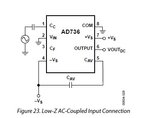The 1rst algorithm you posted, already provide a guideline to calculate, based on root-mean-square formula :
+++
Code:
rawrms += adcbuf[count] * adcbuf[count] ;+++



